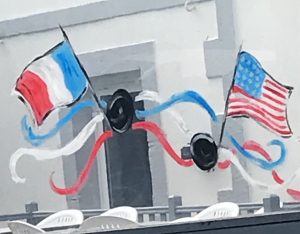There are so many flags on the coast. As we drove along the English Channel (or, as the French insist, the Manche), a plethora of flags littered our view and appeared with increasing frequency the closer we got to Omaha, Gold, and Juno. Every beach, monument, and cemetery was positively dripping with flags – and most of them weren’t French. Rather, the American, Belgian, British, Canadian, Norwegian, and Polish flags flew alongside each other, telling citizens and visitors alike that France’s allies didn’t abandon her when she fell to the Nazis. Standing near them, one could almost hear General de Gaulle’s voice saying, “Elle n’est pas seule.”
I got a similar feeling in London. When walking through the city, one can see monuments and memorials dedicated to foreign armies and military officials. In Hyde Park, Canadian, Australian, and New Zealander monuments stand alongside British memorials. Americans, on the other hand, are commemorated in “Little America” and St. Paul’s Cathedral. London, too, reminds visitors that the UK did not stand alone.
This common theme of international unity unites the British and Norman memories of the war. Rather than only emphasize their nation’s accomplishments, both celebrate the contributions of other nations (or colonies). It’s interesting because it’s so different than the way Americans commemorate the past. We tend to focus on us: our victories, losses, and strategies. It’s almost as if our role in a conflict matters more than the conflict itself.
This is not to say that the UK and France are recognizing other nations out of the goodness of their hearts. Rather, the memorials in London are a way for the UK to place themselves at the top of the Commonwealth’s hierarchy and downplay the nationhood of Australia, Canada, and New Zealand, giving the monuments an almost neo-imperialistic element. In Normandy, the flags’ constant presence allows Frenchmen to uphold the Gaullist myth of a nation in resistance. Placing the French flag alongside those of the liberating Allies, France separates the common people from the Vichy government and inserts itself into the liberation story.
Skip to content
Skip to main navigation
Report an accessibility issue
